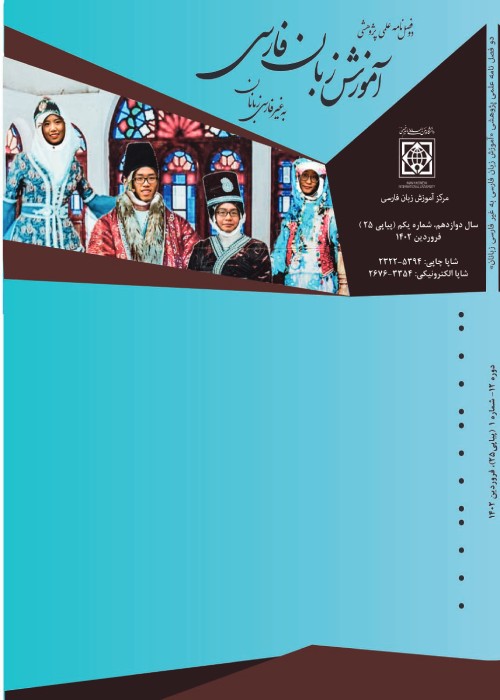Analyzing the Post-Reading Questions of Primary School Persian Textbooks in Terms of Barrett’s Taxonomy
This paper attempted to study the post-reading questions of Persian textbooks used at primary schools (4th, 5th and 6th grades) in terms of Barrett’s taxonomy. The research method was descriptive-analytic. At first, the post-reading questions of the textbooks were counted (394) and they were classified into 5 levels and 27 sub-categories of Barrett’s taxonomy. Then, the distribution of questions at different levels of the reading taxonomy was explored. Results from the codification of the 394 questions showed that the questions were not evenly distributed among the five levels of the taxonomy. The majority of the questions were of the recall type. High frequency of recall questions in the 4th</sup>, 5th</sup>, and 6th</sup> grade books showed that majority of the questions (64.10%) dealt with lowest level of reading skill. In addition, a significant difference was found between the post-reading questions of the textbooks in their inclusion of different levels of reading skill. That is, as the students proceeded to higher grades and their cognition and language competence developed, the level of questions became higher. The findings of this study can be used as a guide to textbook designers (in writing questions) and teachers (in answering questions) to modify their materials and practice to achieve the teaching-learning objectives of the reading skill. Extended Abstract</strong> This paper attempted to study the post-reading questions of Persian textbooks used at primary schools (4th</sup>, 5th</sup> and 6th</sup> grades) in terms of Barrett taxonomy. It is crucial to investigate what kind of cognitive skills are expected to be used in the post-reading questions of the present textbooks. Barrett’s taxonomy categorizes reading comprehension skills into five levels of comprehension. They are presented in the hierarchy from the lowest to the highest level of reading including literal, reorganization, inference, evaluation, and appreciation. The Barrett’s taxonomy was originally designed to assist classroom teachers in developing comprehension questions and test questions for reading. It is especially useful for classroom questioning in other content areas as well. The first two categories, literal comprehension and reorganization, deal with the facts as presented directly in the books the students have read, and thus result in closed questions that have a single correct response. Literal comprehension focuses on ideas and information which are explicitly stated in the selection. Purposes for reading and teacher’s questions designed to elicit responses at this level may range from simple to complex. Reorganization requires the student to analyze, synthesize, and organize ideas or information clearly stated in the passage. The remaining categories will always involve the student’s own background of experience. As a result, it is possible to have as many different, but correct, responses as there are students present, since each brings to school a different background of home, family, friends, and learning. These categories therefore lead to the development of open-ended questions. Inferential comprehension is stimulated by purposes for reading and teachers’ questions which demand thinking and imagination that go beyond the printed page. Personal experience is interpreted to include formal learning experiences, as well as those things which the reader has personally experienced in a first hand situation. Prior knowledge, regardless of where this knowledge came from, is an integral part of inference. The crucial factor distinguishing inference questions from recognition and recall questions is that their answers are not explicitly stated but must be inferred. Purposes for reading and teacher’s questions, in evaluation, require responses by the student which indicate that he or she has made an evaluative judgment by comparing ideas presented in the selection with external criteria provided by the teacher, other authorities, or other written sources, or with internal criteria provided by the reader’s experiences, knowledge, or values. Evaluation deals with judgment and focuses on qualities of accuracy, acceptability, desirability, worth, or probability of occurrence. Appreciation involves all the previously cited cognitive dimensions of reading, for it deals with the psychological and aesthetic impact of the selection on the reader. Appreciation calls for the student to be emotionally and aesthetically sensitive to the work and to have a reaction to the worth of its psychological and artistic elements. Appreciation includes both the knowledge of and the emotional response to literary techniques, forms, styles, and structures. The research method of this paper was descriptive-analytic. At first the post-reading questions of the textbooks were counted and they were classified according to Barrett’s taxonomy. Then the data were analyzed considering their distribution at different levels of the reading taxonomy. Results from the codification of questions showed that the majority of the items concentrated on the first level of Barrett’s taxonomy which is referred to as the lower level of reading skill. In addition, a significant difference was found between the post-reading questions of the textbooks in their inclusion of different levels of reading skill. That is, as the students proceeded to higher grades and their cognition and language competence developed, the level of questions became higher. The findings of this study can be used as a guide to textbook designers and teachers to modify their materials and practice to achieve the teaching-learning objectives of the reading skill. Therefore, it is important for teachers to realize that they should carefully analyze the questions in a textbook and evaluate for themselves whether or not they deem the questions to be adequate or appropriate for their students, and not just to blindly accept and use the questions given in textbooks. If the questions in textbooks are not adequate, teachers need to prepare other questions by themselves. To promote student cognitive skills, it is necessary to build teacher’s competence for making appropriate cognitive questions. A mixture of questions at various levels of the taxonomy might result in effective learning at higher and lower levels of thinking skills. The advantage of having textbooks with mixed questions (questions at all levels) is that low ability students perform better on knowledge recall questions and high ability students perform better on inference, evaluation, and appreciation level questions.
- حق عضویت دریافتی صرف حمایت از نشریات عضو و نگهداری، تکمیل و توسعه مگیران میشود.
- پرداخت حق اشتراک و دانلود مقالات اجازه بازنشر آن در سایر رسانههای چاپی و دیجیتال را به کاربر نمیدهد.



